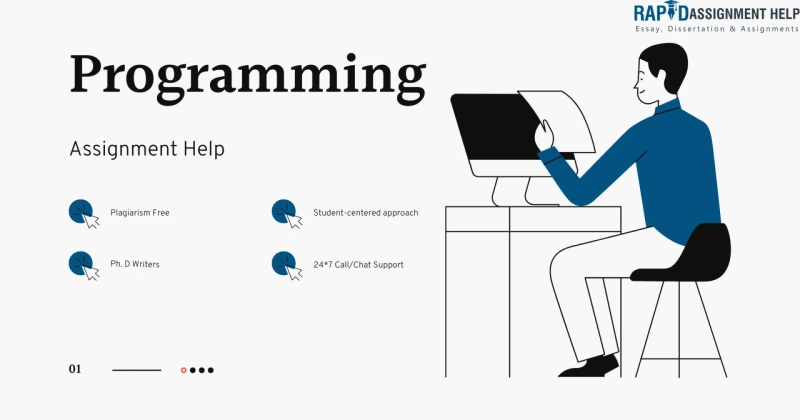Introduction
As a programming student, you're likely to encounter the need to work with files — whether you're reading configuration data, saving user inputs, or processing logs. This is where file handling comes into play. It allows your programs to interact with files on a system, making your software more practical and data-driven.
For UK students learning coding, file handling is a foundational topic that bridges theory with real-world applications. This article explores the key concepts, common functions, best practices, and practical examples you’ll need to handle files effectively. If you're ever unsure, help is always available through resources like Programming Assignment Help.
What Is File Handling?
File handling in programming refers to the ability to create, read, write, and delete files using code. It enables persistent storage — meaning data can be saved and accessed even after the program stops running.
Most programming languages offer built-in methods to manage files stored on your computer or server.
Types of File Modes
When handling files, you often need to specify the mode — what you want to do with the file:
ModeDescriptionrRead (default)wWrite (creates/overwrites file)aAppend (adds to end of file)xCreate (fails if file exists)bBinary modetText mode (default)+Read and write
You can combine these — e.g., rb for reading a binary file or w+ for writing and reading.
File Handling in Python: A Simple Example
Let’s start with one of the most student-friendly languages — Python.
Writing to a File
python
CopyEdit
with open("example.txt", "w") as file:
file.write("Hello, world!")
Reading from a File
python
CopyEdit
with open("example.txt", "r") as file:
content = file.read()
print(content)
Appending to a File
python
CopyEdit
with open("example.txt", "a") as file:
file.write("\nAnother line.")
The with keyword ensures the file is automatically closed after use, which is considered best practice.
File Handling in Other Languages
Java
java
CopyEdit
import java.io.FileWriter;
import java.io.FileReader;
import java.io.IOException;
public class FileExample {
public static void main(String[] args) throws IOException {
FileWriter writer = new FileWriter("example.txt");
writer.write("Hello, Java!");
writer.close();
FileReader reader = new FileReader("example.txt");
int data;
while ((data = reader.read()) != -1) {
System.out.print((char) data);
}
reader.close();
}
}
C++
cpp
CopyEdit
#include <iostream>
#include <fstream>
using namespace std;
int main() {
ofstream outFile("example.txt");
outFile << "Hello from C++!";
outFile.close();
string line;
ifstream inFile("example.txt");
while (getline(inFile, line)) {
cout << line << endl;
}
inFile.close();
return 0;
}
Common Operations in File Handling
1. Reading Line by Line
Useful for large files.
python
CopyEdit
with open("example.txt", "r") as file:
for line in file:
print(line.strip())
2. Checking File Existence
python
CopyEdit
import os
if os.path.exists("example.txt"):
print("File exists")
else:
print("File does not exist")
3. Deleting a File
python
CopyEdit
import os
os.remove("example.txt")
4. Working with Directories
python
CopyEdit
os.mkdir("new_folder")
os.rmdir("new_folder")
Why File Handling Matters
File handling is essential in real-world software systems:
✅ Persistent Storage
Data remains available even after the program ends.
✅ Data Logging
Used for logging user activity, errors, and system performance.
✅ Configuration Management
Apps often read settings from configuration files (like .ini, .json, .xml).
✅ Reporting and Output
Storing results of computations or analysis (e.g., saving exam scores).
File Formats You May Encounter
1. Text Files (.txt)
Plain text, readable and editable manually.
2. CSV Files
Comma-separated values — commonly used in data analysis.
python
CopyEdit
import csv
with open('data.csv', mode='r') as file:
reader = csv.reader(file)
for row in reader:
print(row)
3. JSON Files
JavaScript Object Notation — used for structured data.
python
CopyEdit
import json
with open('data.json') as f:
data = json.load(f)
print(data)
File Handling Challenges for Students
Students often struggle with:
- Forgetting to close files (leading to memory leaks)
- Using the wrong mode (
rvsw) - Mishandling file paths, especially in cross-platform environments
- Overwriting files accidentally
- Dealing with file encoding or binary data
These are common learning curves. With practise and support from peers or services like Programming Assignment Help, you can master file handling with confidence.
Best Practices for File Handling
✅ Always Close Your Files
Use with statements or remember to close files manually.
✅ Check File Existence
Avoid errors by verifying a file exists before trying to open it.
✅ Handle Exceptions
python
CopyEdit
try:
with open("example.txt", "r") as file:
print(file.read())
except FileNotFoundError:
print("The file does not exist.")
✅ Use Relative Paths for Portability
This avoids hardcoding absolute paths that won’t work on other machines.
python
CopyEdit
with open("data/example.txt", "r") as file:
# good practice for portability
✅ Avoid Overwriting Files Unintentionally
When writing, check if the file already exists.
File Handling in University Assignments
In UK computer science courses, file handling is often included in assignments related to:
- Data processing (e.g. student records)
- Command-line tools
- Logging systems
- Reading configuration files
- Mini projects like address books or note-taking apps
These assignments aim to simulate real-world scenarios where persistent data storage is essential.
Real-World Applications of File Handling
🧾 In Accounting Software
Transaction logs and invoices are often stored as files.
📊 In Data Science
Data sets are loaded from CSV or JSON files, processed, and then written to new files.
📦 In Web Development
Web apps may log user actions or save form submissions to files before inserting into databases.
🧠 In AI and Machine Learning
Models are saved and loaded as binary files (like .pkl in Python or .h5 in Keras).
Conclusion
File handling is a foundational topic in programming, allowing your software to interact with the real world by reading, writing, and storing data. For UK students, mastering file handling is key to passing modules and building practical applications.
Whether you’re managing text files, logging system errors, or working with structured data formats like CSV and JSON, file handling opens the door to developing real-world software. As always, if you encounter difficulties, expert guidance is available through resources like Programming Assignment Help to support your learning.


